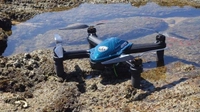Seahorse Trident BOSS+ Drone Electric Pack
Buy now, pay later & Finance Options
Find Local Store
This is the perfect set-up for drone-based longline fishing. Match the powerful CutaCopter Trident V6X Drone with the Seahorse Drone Winch and Drone Traceboard.
Fishing Drones combine the technology of avionics, electronics and robotics to create a flying machine.Seahorse add complexity by pulling a line from the beach over the water. When flying a drone, you are a pilot, and as the pilot, you want to have the best, most advanced and most reliable technology working for you. This is what you get with the new Cuta Copter Trident V6X.
TRIDENT V6X Drone with the Seahorse Drone Winch and TraceboardThe Trident V6X has the pilot and people's safety at the centre of the design. The drone hardware, like frame, bait release, flotation, etc., is only one part of the equation. How the drone flies and reacts to the pilot's instructions is an essential part of the design of a successful drone.
The Trident Drone is a development of the EX-2, which was developed from the REVO4 and Matrix drones. The Trident is designed from the ground up as a fishing drone. Each new model from Cuta Copter is built on the knowledge and experiences gained from users from around the globe, and the aim is to build the best fishing drone possible.
The Trident V6x is a powerful fishing drone that can lift large baits or payloads. The Trident will happily pull 25 hooks out to 1000 meters or carry a large single bait up to 3.5 kg over a shorter distance. Most people are finding 13 hooks (one side of the traceboard is a good working number, allowing a larger weight to be used). The Trident has a special flight mode to soften the responses that reduce the pendulum effect.
The number of sets you can do depends on the weight and drag of your payload, the distance of the set, and the wind conditions. If you are dropping your baits at 400 meters if the payload/drag is 1kg, you should get up to seven sets, 2 kg drops the number to five, and 3.5kg loads will drop the sets to three.
The Trident V6X is easy to fly, and the Skydriod App gives verbal and visual messages and warnings of any significant events. This means the pilot is always informed.
Seahorse Drone WinchThe Seahorse Drone Winch is a modified version of Seahorse's successful Braid Winch. It brings all the advantages of a powerful Kontiki winch to drone fishing and is perfect for those who want to set multiple hooks along the way out to Sea. The Seahorse Drone Traceboard is perfect for holding drone tube traces.
The Seahorse Drone Winch comes with the following:
Features:- 1000 Metres of 130lb B/S braid
- 50 meters of polyester line with 30 loops for traces and weights.
- 10ah lithium battery and battery charger
- Manual rescue handle
- Warranty
- Seahorse Drone Winch
The Seahorse Drone Winch is powered by a 150-watt motor (like Seahorse's other Seahorse winches) and uses a 10ah Red Lithium battery.Seahorse have re-designed the drum with a larger core to hold the lighter braidSeahorse use with the drone. Then ensures the drum rotates slower on deployment and retrieves the line quicker on retrieval.
At 12.5kgs with line and battery, it is light and easy to carry.
Due to the Braid line and the low drag design of the Seahorse S30 Kontiki, this battery can retrieve the Kontiki unit up to three times on one battery.Seahorse have made the Winch simple to use with a soft start three-speed control unit, ensuring full power is delivered to the motor no matter what.Seahorse have retained the Pulse function, allowing you total control over the Winch whenever needed.
The 130lb Braid is light enough for the Trident Drone to pull out, yet it is strong enough to cope with most of the loads you could get from doing long sets. Sometimes the conditions or weeds in the water can cause extra load on the line, and the 130lb B/S is strong enough to cope with most situations (if care is taken).
The polyester line has 30 loops tied into it. This is sufficient for 25 hooks, three weights, and connecting to the drone and the braided line. If you are fishing with fewer hooks, the line can be shortened to the length you require. The Longline clips are easy to clip onto and remove from the loops. Simply bait up and connect the traces and weights to the line. Connect the line to the drone, and away you fly. With smooth (consistent speed) flying, there is no need for any drag on the line, and the large diameter drum allows fast deployment of the line out to 1000 meters. Under the 1000 meters of 130lb B/S braid, there are 200 meters of 300lb B/S braid, and the change in line thickness is a clear indication to drop the line. Finally, there is some nylon that binds the braid to the winch drum.
Winch Or ReelThe winch has the advantage if you are doing long sets with 13 or more hooks. The large drum manages the line better and can pull everything back from that distance.
The top-of-the-range Electric Fishing Reels can hold up to 1100 meters of line, but they cost the same or maybe more than the winch. The smaller electric reels can hold up to 650 meters of 80lb braid, andSeahorse find the smaller electric reels are better suited to shorter (up to 500 meters) runs or with fewer hooks.
Manual fishing reels can also be used, but once you get beyond 300 meters, winding the line in can be tedious.
Seahorse Drone TraceboardThe Drone Traceboard is 300mm shorter than the standard Seahorse Traceboard and holds traces 500mm long. The traces have tubes on them to reduce twisting and tangling as the drone flies the baits out to Sea. The traces have longline clips, which are easy to clip on and remove the traces from the looped line.
The traceboard comes with 26 tube traces.
The 6oz breakaway sinkers also have longline clips and a swivel. It is recommended to place a rubber band around the breakaway spikes to increase the breakaway pressure. This will allow the line to be pulled tight from the weights back to the winch.
Set-up for LaunchingWith the speed of the drone, you need to have everything set up before you take off. Some people stretch the line up and down the beach, but the seagulls will attack your baits and get everything tangled. It is best to lay the traces out side by side with the polyester line looping away from the traces. With liftoff, the traces will then be lifted up into the air by the drone, not dragged across the beach from where they were lying to where the drone is.
As the bait starts lifting into the sky, you can start flying the drone forward (and up), but care is needed to ensure the line comes off the winch in a consistent manner.
Drones are a fantastic way to get your bait out where the big fish are.
However, there are a few safety considerations that are important to understand and follow when flying a drone:
1. You are operating a semi-autonomous aircraft. They are not toys and need to be respected. Learn how to operate them safely.
2. Don’t fly the drone near people, animals, buildings or other items that might be damaged. Fly only in open areas and remain aware of your surroundings.
3. Never try to grab or catch the drone when its propellers are running. The props are sharp and will cause serious injury to any body part that get in their way.
Fishing Drone Warranty Details
We've got you covered if your drone has a manufacturing fault. But we don't cover damage caused by crashing or not following the instructions.
Sometimes, it's tricky to 100% determine if the problem is a product fault or user error. In those cases, we'll propose a solution that could work for both of us. This solution is likely to involve splitting costs for replacement or repair. If we can't help with a warranty repair or replacement, we'll send your drone back to you in the same condition as received.
It's also worth remembering that the drone, the batteries, and the accessories all have differing warranty periods, as indicated in your manual. This is because batteries, in particular, need to be stored and charged according to the manual.

















